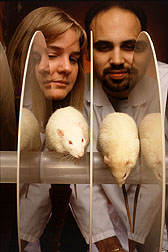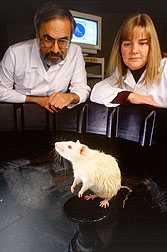Can Foods Forestall Aging?
Studies at the Jean Mayer USDA Human Nutrition Research Center on Aging at Tufts University in Boston suggest that consuming fruits and vegetables with a high-ORAC value may help slow the aging process in both body and brain. ORAC--short for Oxygen Radical Absorbance Capacity--measures the ability of foods, blood plasma, and just about any substance to subdue oxygen free radicals in the test tube.
Early evidence indicates that this antioxidant activity translates to animals, protecting cells and their components from oxidative damage. Getting plenty of the foods with a high-ORAC activity, such as spinach, strawberries, and blueberries, has so far:
- raised the antioxidant power of human blood,
- prevented some loss of long-term memory and learning ability in middle-aged rats,
- maintained the ability of brain cells in middle-aged rats to respond to a chemical stimulus, and
- protected rats' tiny blood vessels—capillaries—against oxygen damage.
These results have prompted Ronald L. Prior to suggest that "the ORAC measure may help define the dietary conditions needed to prevent tissue damage."
Prior is coordinating this research with Guohua (Howard) Cao, James Joseph, and Barbara Shukitt-Hale at the Boston center.
Science has long held that damage by oxygen free radicals is behind many of the maladies that come with aging, including cardiovascular disease and cancer. There's firm evidence that a high intake of fruits and vegetables reduces risk of cancer and that a low intake raises risk. And recent evidence suggests that diminished brain function associated with aging and disorders such as Alzheimer's and Parkinson's diseases may be due to increased vulnerability to free radicals, says Joseph, a neuroscientist.
Such evidence has spurred skyrocketing sales of antioxidant vitamin supplements in recent years.
But several large trials testing individual antioxidant vitamins have had mixed results. "It may be that combinations of nutrients found in foods have greater protective effects than each nutrient taken alone," says Cao, a chemist and medical doctor.
For example, foods contain more than 4,000 flavonoids. These constitute a major class of dietary antioxidants and appear to be responsible for a large part of the protective power of fruits and vegetables, Cao says.
By the year 2050, nearly one-third of the U.S. population is expected to be over age 65. If further research supports these early findings, millions of aging people may be able to guard against diseases or dementia simply by adding high-ORAC foods to their diets. This could save much suffering, as well as reduce the staggering cost of treating and caring for the elderly.
Cao developed the ORAC test while he was a visiting scientist at the National Institute on Aging in Baltimore, Maryland. After joining Prior's group 5 years ago, the researchers assayed commonly eaten fruits, vegetables, and fruit juices with ORAC. [See "Plant Pigments Paint a Rainbow of Antioxidants," Agricultural Research, November 1996, pp. 4-8.]
"The ORAC value covers all the antioxidants in foods," says Cao. "You cannot easily measure each antioxidant separately," he adds. "But you can use the ORAC assay to identify which phytonutrients are the important antioxidants."
The researchers have been testing whether antioxidants other than vitamins are absorbed into the blood and protect the cells. And the results look promising.
Its in the Blood
Several laboratories have reported that people can absorb individual flavonoids thought to have protective powers. Prior and Cao now have good evidence that food antioxidants not only are absorbed, they boost the antioxidant power of the blood.
In an earlier study at the Boston center, 36 men and women ranging in age from 20 to 80 had doubled their fruit and vegetable intake. According to the participants' responses on a food frequency questionnaire, they averaged about five servings of fruits and vegetables daily during the year before the study. That intake was doubled to 10 servings of fruits and vegetables daily during the study.
To estimate ORAC intakes for the participants, the two researchers matched the questionnaire and the diet data with their own antioxidant values for each fruit and vegetable. Before the study, says Prior, the participants averaged 1,670 ORAC units daily. Increasing their fruit and vegetable intake to 10 a day raised the ORAC intake to between 3,300 and 3,500 ORAC units—or about twice the previous antioxidant capacity.





